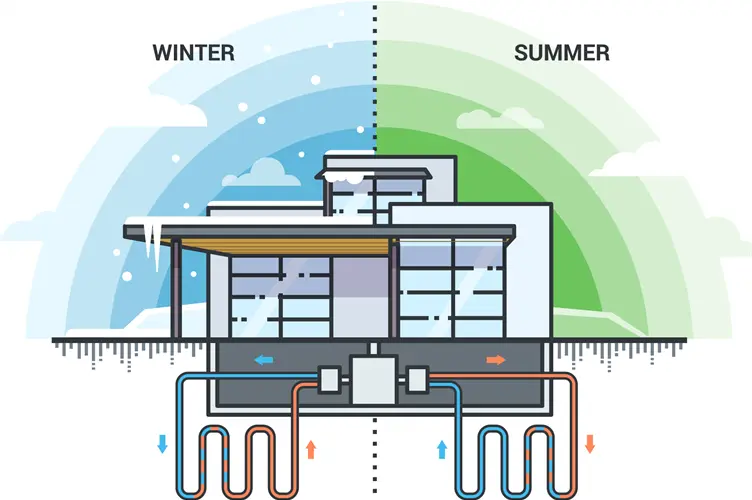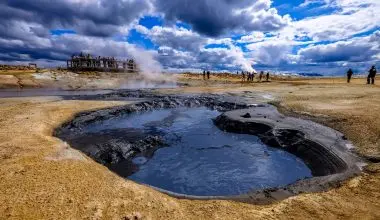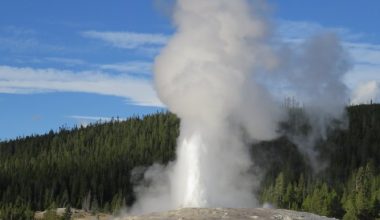Table of Contents Show
Geothermal has become one of the least talked about forms of renewable energy even though we’ve been using it for everyday operations since the 1940’s.
Geothermal Heat Pumps use high temperatures from the earth’s core for heat supplementation during winter, whereas, in summers it can use the earth as a heat sink to drain heat from the surface.
It has a tried and tested technology and is considered to be more efficient as compared to other methods and forms of renewable energy.
They can provide cooling without noise and heating without pollution, all the while reducing your energy bills by almost 70%!
Did you know? A Geothermal Heat Pump is 400% efficient!
Geothermal energy is used in all 50 states of The United States. The US has around 80000 geothermal heat units installed every year.
27000 units are installed in Sweden yearly. Due to their high demand, Global market share of geothermal energy was valued at $4.6 billion in 2018 with an expected rise to $6.8 billion by 2026.
Those were just a few facts showing how people have started getting on the train to clean and green heating.
How do Geothermal Pumps work?
Geothermal heat pumps are also called ground-source heat pumps, which use underground heat by pumping water through the ground. The ground temperatures range from 7 to 21 degrees depending upon your geographical location.
The heat pump uses this temperature to heat your home or water. It does use some amount of electricity but the amount is much less when compared to how much would be needed to produce similar amounts of heat otherwise. It works like a boiler but the heat pump uses air from the ground rather than burning fuel for it.
The water underground is warmer in winters and cooler in summers, exactly like a cave.
Geothermal system components
A geothermal pump has many small components including a ground loop which is a very essential set of interlinked pipes which are underground. However, the heat pump is installed at ground level. The size of your house determines the size of the ground loop as well as how much heat would be required. The heat pump would require more space if you need the size of the loop to be large.
The heat pump consists of the following components:
- A Compressor
- A Condenser
- A Evaporator
So the heat pump and the loop piping makes up the whole geothermal pump system.
Mechanics of Geothermal Heat Pumps
The water pipes pump a mixture of water and antifreeze underground. The heat pump is then used to pump back out this mixture and subsequently extract the heat from it so that it can be transferred to your home. The extracted heat is relayed to the heating system which increases the indoor temperatures.
Geothermal pumps actually go ahead and increase the temperature substantially from 1.5 to 4 times. It would mean that if the water extracted is of 11 degrees celsius, then it can reach upto between 18 to 48 degrees by the time it reaches your home.
This water can then be used for taking baths and hot showers all-the-while stored heat is being sent back to the radiators for heating up your homes.
Leftover heat can be stored in the form of hot water cylinders and be used later on.
For clarifying your concepts you can watch this 2-minute video on How geothermal heat pumps work to maintain indoor temperatures.
Now that you know the Mechanics of Geothermal Heat Pumps; I’d like you to know the advantages and disadvantages of Geothermal Heat Pumps as well!
Advantages of Geothermal Heating Pump System
Geothermal heating pump station is very ideal to keep your house warm during the months of winter as well as keep your home cool in summers. It uses a natural source of heat which is why it has low carbon footprint impact and can help reduce your energy bills. Read up on other advantages below.
Geothermal Heat Pumps Save Money
You can save your hard-earned money (by lowering 40-60% of your bills) when you install geothermal heating pumps. It will initially cost you around $3000-8000 including the installation costs, heat pump, underground loops and controls.
If you include the annual 4% rise in maintenance costs and utility bills, your savings go around $50,000 over the 20-year lifespan of the geothermal HVAC system.
Government Incentives
The pump cost is a substantial investment. Therefore, many countries provide incentives to make it easier for people to install geothermal heating pumps. In some countries you can even get tax credits.
If you’re in the US and don’t have a geothermal heat pump; you should seriously consider buying one because the tax credits on geothermal are going down year after year.
As of 2020, you get 26% credit on installation according to ‘The Energy Credit’. This will get even lower in 2021 to 22% only.
How to get this ‘Energy Credit’ for your heat pumps?
You can use the IRS form 5695 to claim the Residential Energy Efficient Property Credit. If your house is built after 2009; Good News, there’s no limit on that credit!
However, you should read the Terms and Conditions on the form properly! At least to make sure you’re eligible.
Return on Investment
Even if you don’t get government incentives you can see a return on your investment. It takes anywhere between 2-8 years to get a return on investment; as estimated by the Air Force Institute of Technology.
It can help you save around $480 to $2400 every year. But it all depends upon the type of heating system you install.
High Efficiency
Geothermal heating is considered as one of the most efficient ways to heat your home. Even though it uses minimal electricity to power the heat pump; you get to make much more energy for every unit of electricity you pay for.
Geothermal heating systems have an efficiency of 400%! The whole process saves up to 70% of your heating and cooling bills.
Efficient Cooling of your House
When it comes to cooling your home, geothermal pumps are also an efficient choice. The heat pump takes the heat from your home and transfers it outdoors or into the ground depending on the type of geothermal system installed.
Environmental Advantages of Geothermal Heating Pumps
Renewable and Sustainable Source of Energy
Geothermal energy is entirely steady and sustainable. The solar and wind energy both change with seasonal variations. Geothermal is consistent in its function of maintaining indoor temperatures, no matter what the weather is.
Highly Accessible and Reliable
Several energy sources like Wind and Solar require a good amount of space for installation. Many people are not able to set up geothermal plants in their homes because of limited space but you can still have one in your area or you can share one with your neighbors.
Steam beds closer to the surface makes it easier for individuals and companies to reach them out and use them for geothermal heating.
Low Greenhouse Gas Emissions
The heat pump emits considerably lower CO2 when compared with other conventional heating systems. This happens because the heat pumps rely on ground temperatures, need minimal electricity and are very efficient.
Disadvantages of Geothermal Heating Pumps
Requires Excavation
One of the problems with geothermal is that it requires some pre-work before installation like underground excavation to place looping pipes; unlike wind and solar energy equipment.
Digging the ground is an absolute necessity because you’re connecting your house with it. This makes it a bit hard to install for the laymen and makes it more cost prohibitive than other forms of energy.
Many people are able to do it because their homes are built on solid grounds but still the project is not easy to do and is expensive.
Uses Local Water Resources
In large-scale geothermal power plants, geothermal energy is used to run water underground and heat it up, that hot water will then be used to generate power. It is estimated that a single plant uses around 1700 to 4000 gallons of water to produce one megawatt hour of electricity. The limited supply of water is an issue.
Region Prohibitive
Geothermal energy is not accessible in all areas. In many areas the water table is deeper in the ground which makes it very difficult for the plant to operate as it would require more digging which might not be allowed in many neighbourhoods.
Environmental Disadvantages of Geothermal Heat Pumps
Excavation (Digging):
Excavation has its environmental downsides. First and foremost; if you install it in your garden, you’ll have to develop the garden and the whole landscape again after pipes are installed. Although there’s nothing I like more than developing a garden and planting trees and redoing landscapes, others may think it’s an added effort.
The other impact of excavation is soil damage. Soil damage includes silt-like stormwater runoff and soil pollution. However, you can notify your company to ensure minimal damage while excavation.
Conclusion
Geothermal heat is a terrific option if it’s feasible at your geographic location, especially if you’re in the US. When you go back and read the advantages of such a system, you will realize how beneficial geothermal heat pump are actually; Economically as well as Environmentally. If you’re considering to make a shift to renewable energy, this is a terrific option for you and your family!
Let me know your thoughts in the comments below. Hope you have a Great Day!



